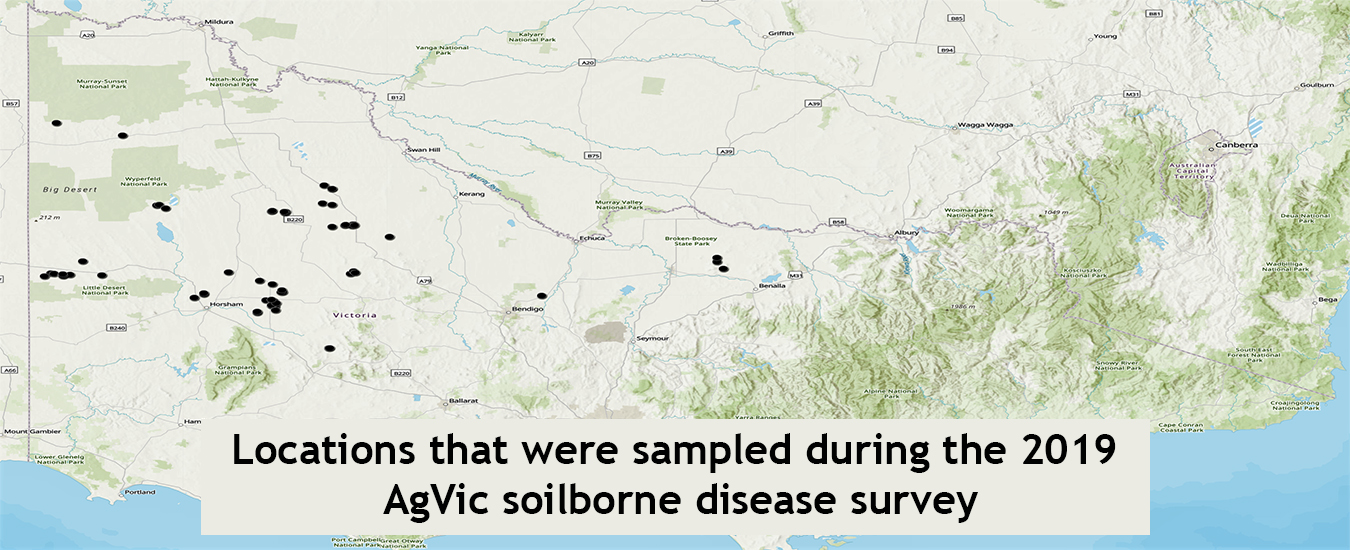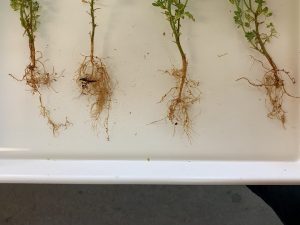Soil-borne diseases are of increasing importance in pulse and oilseed crops. During 2019, a survey of 67 crops by Agriculture Victoria showed severe root damage in chickpea and faba bean crops. Analysis of plant roots identified the most common root diseases were root lesion nematode, pythium root rot, charcoal rot, and rhizoctonia. Further work is required to understand the link between root disease symptoms and the soil-borne pathogens identified in these samples.
Little is known about soil-borne diseases in pulse and oilseed crops. Within Victoria, “poor performing” patches within crops are usually attributed to “bad soil”. However, there are a range of reasons, including: nutrition, water logging, gypsum piles or chemical spillage, and soil-borne disease that can contribute to poor crop performance. The extent of loss within individual crops can be high. Investigation of these patches has identified significant levels of blackening of roots which is a symptom of root disease. Interestingly, root disease symptoms are often found in ‘healthy’ looking pulse crops.
A component of a national GRDC soil-borne disease project is investigating soil-borne diseases in pulse and oil-seed crops. Samples from “poor performing areas” in pulse and oilseed crops are being requested from agronomists. See details below for how to participate.
- Lentil plants
- Lentil plants
Samples received undergo an extensive analysis process. This includes a visual assessment of roots for symptoms of disease, molecular testing using PREDICTA®B, culturing of pathogens from samples with significant disease, and advanced molecular techniques. This comprehensive analysis allows researchers to accurately diagnose what is causing most of these patches and will inform priorities for yield loss studies in the future.
During 2019, 67 samples were assessed across Victoria, including samples from canola, chickpea, faba bean, lentil, lupin and vetch paddocks. These samples were assessed visually for root disease symptoms and were sent to SARDI for molecular analysis of pathogens on the roots. Based on the visual assessments, the chickpeas and beans showed the most root disease symptoms among all surveyed crop types with an average of 51-75% blackened/rotting roots. Only one sample from each of canola and lupin were assessed with very little disease detected in these samples at less than 10%. Each paddock had a root health assessment completed on a 0-6 scale, where 0= 0%, 1 = 1-10%, 2 = 11-25%, 3 = 26%-50%, 4 = 51-75%, 5 = 76-99%, 6 = 100% damaged roots with browning, blackening and/or rotting symptoms (Table 1).
Table 1. Average root health score (where 0 = healthy and 6 = 100% damage) for each crop across Victoria
| Summary | Canola | Chickpea | Faba Bean | Lentil | Lupin | Vetch |
|---|---|---|---|---|---|---|
| Number of crops | 1 | 21 | 11 | 30 | 1 | 3 |
| Average root health Score | NAa | 4.5 | 4.8 | 3.2 | NAa | 3.7 |
In addition to visual assessments, samples were also sent to SARDI for molecular analysis on the plant roots. The root diseases with the highest frequency across most of the pulse and oilseed crops were root lesion nematode, pythium root rot, charcoal rot and rhizoctonia. A full breakdown is presented in Table 2.
Table 2. Number of paddocks with each pathogen detected ranked from most frequent to least frequent (total paddocks = 67)
| Disease | Pathogen | Canola | Chickpea | Faba Bean | Lentil | Lupin | Vetch | Total of all paddocks (%) |
|---|---|---|---|---|---|---|---|---|
| Blackspot of field peas | Didymella pinodes/Phoma pinodella | 1 | 21 | 11 | 28 | 1 | 2 | 95.5 |
| Root lesion nematode | Pratylenchus neglectus | 1 | 21 | 9 | 26 | 0 | 1 | 86.6 |
| Charcoal rot | Macrophomina phaseolina | 1 | 16 | 11 | 14 | 1 | 1 | 65.7 |
| Pythium | Pythium clade f | 1 | 12 | 11 | 14 | 1 | 2 | 61.2 |
| Pythium | Pythium clade I | 0 | 12 | 9 | 15 | 0 | 0 | 53.7 |
| Ascochyta blight (chickpeas) | Phoma rabiei | 0 | 17 | 3 | 11 | 0 | 0 | 46.3 |
| Root lesion nematode | Pratylenchus thornei | 0 | 14 | 5 | 5 | 0 | 1 | 37.3 |
| Blackleg | Leptosphaeria maculans | 1 | 4 | 9 | 5 | 0 | 0 | 28.4 |
| Rhizoctonia | R. solani AG2.1 | 1 | 5 | 4 | 8 | 0 | 28.4 | |
| Rhizoctonia | R. solani AG8 | 1 | 1 | 4 | 8 | 0 | 0 | 20.9 |
| Eradu patch | Unnamed thin binucleate rhizoctonia (TBR) | 1 | 0 | 4 | 1 | 0 | 0 | 9 |
| Sclerotinia | Sclerotinia sclerotiorum | 0 | 1 | 3 | 2 | 0 | 0 | 9 |
| Aphanomyces | Aphanomyces trifolii | 0 | 0 | 4 | 1 | 0 | 0 | 7.5 |
| Phytophthora root rot | Phytophthora clandestina | 1 | 0 | 0 | 0 | 1 | 0 | 3 |
| Phytophthora root rot | Phytophthora medicaginis | 0 | 0 | 0 | 1 | 0 | 0 | 1.5 |
| Root lesion nematode | Pratylenchus quasitereoides | 0 | 0 | 0 | 0 | 1 | 0 | 1.5 |
| No. of Paddocks | 1 | 21 | 11 | 30 | 1 | 3 |
This work is continuing in 2020 and we are again urging growers and agronomists to get in touch if they have areas of pulse or oilseed paddocks with poor establishment or ill thrift. Sampling kits can be requested by getting in touch with us using the below contact information, with all results to be made available to the agronomist or grower.
For more information please contact Agriculture Victoria scientists:
Jon Baker
0428 629 260
[email protected]
or
Dr. Joshua Fanning
0419 272 075
[email protected]
Further information
Acknowledgements
Thank you to Grant Hollaway (Agriculture Victoria, Senior Research Scientist – Field Crop Pathology) for his contributions and expertise.
The authors wish to acknowledge the funding provided by GRDC that allows this work to occur. This information has been generated by the GRDC funded project DJP1907-002RMX.





